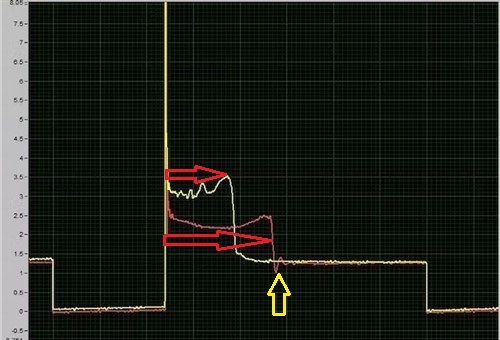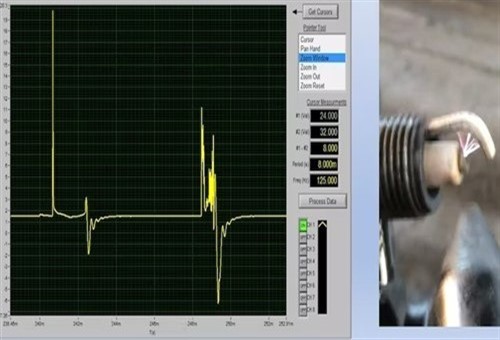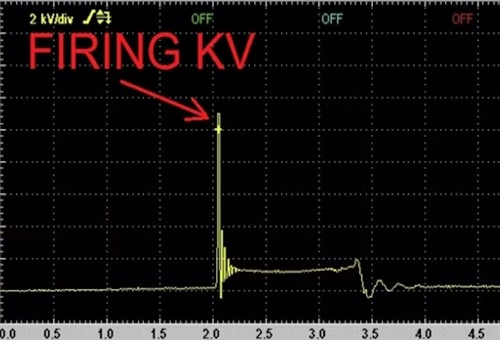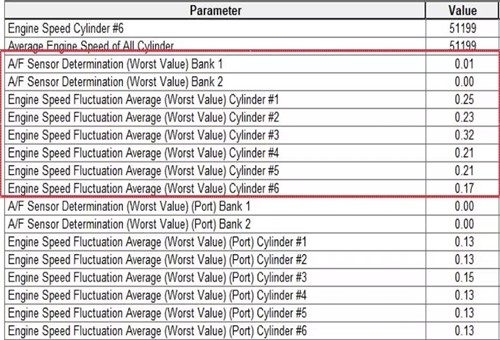
In theory, it should be easy to diagnose and fix most misfires. After all, proper ignition and combustion in a spark ignition engine require only cylinder compression, fuel, and an ignition source all being present and correct at the right time to complete successfully. So, when one of these things is not present or inadequate, ignition and/or combustion events might not compete successfully, if at all, and the engine management system will set one or more misfire codes as a result.
However, the practice is somewhat different, because all, or at least, most of us, have seen active misfire codes on spark ignition engines that were running as smoothly as proverbial Swiss clocks, i.e., without any signs or evidence of misfires being present. Oftentimes, we see these codes as ghost codes, computer glitches, or worse, as programming errors, but the truth of the matter is that in the vast majority of these cases, the engine management system correctly reported what it considered to be a misfire.
Put differently, this means that the misfire detection system, working in conjunction with the larger engine management system, was working as designed, but it was working in ways that we did not expect. Thus, in this article, we will discuss apparent “ghost” misfire codes on spark ignition engines in terms of what causes them, as well as misfire detection strategies you may not have known about. Before we get to specifics though, it is perhaps worth revisiting-
We all know that misfires create small variations in the rotational speed of a crankshaft, and until comparatively recently, variations in the crankshaft’s rotational speed, as reported by the crankshaft position sensor, was the only criterion the engine management system considered when it decided whether (or not) to record misfires. Moreover, to avoid reporting false positives caused by small distortions of the crankshaft as misfires, engine management systems only considered speed deviations that exceed about 2 per cent of a crankshaft’s average rotational speed (over a fixed number of engine cycles) to be true misfires.
While the early versions of this system worked well enough to detect misfires reliably and consistently, their biggest failing was that they did not disable fuel injectors when misfires did occur, which allowed unburned fuel to enter catalytic converters, which caused the rapid and total destruction of catalytic converters. As a result of this, all major car manufacturers started reprogramming misfire detection systems to disable fuel injectors on cylinders that were experiencing misfires, and this strategy is now a standard feature on all spark ignition engines.
However, as with many advances in automotive technology, the main driving force behind efforts to improve the resolution/efficiency of misfire detection systems had less to do with car manufacturer’s desire to improve their products than it had to do with the demands of the Euro 6 emissions regulations that were introduced in 2014/15. The problem was that since the presence of misfires caused engine management systems to enrich air/fuel mixtures to compensate for the loss of power caused by the misfire(s), the engines of the time could not meet the demands of the newly introduced Euro 6 emissions regulations under some operating conditions.
So while manufacturers were legally obliged to improve misfire detection systems to reduce harmful exhaust emissions, this period also demonstrated that although the combustion process in internal combustion engines had been studied intensely since engines were invented, there were still some major aspects of combustion processes that were poorly understood. The practical upshot of this was that all major manufacturers embarked on hugely expensive research and development programs to a), better understand some internal combustion processes, and b) to produce more fuel-efficient engines to serve as improved research platforms to research internal combustion processes more efficiently.
Limited space precludes a comprehensive discussion of all, or even just the major advances in engine technologies we have seen since about 2015/16, but suffice it to say that the new generation of engines was measurably more fuel efficient than preceding generations. Nonetheless, higher fuel efficiencies as a result of increased dynamic compression ratios and highly specialized piston and combustion chamber designs had some very undesirable unintended consequences. As a practical matter, it turned out that as a general rule, the more fuel-efficient an engine becomes, the more susceptible it becomes to the effects of things like less-than-ideal mixing of the air and fuel, poor or deficient exhaust scavenging, inadequate ignition sparks, and, of course, the effects of poor fuel quality.
While these conditions could create conditions in cylinders that did not produce true misfires (where no combustion takes place), these conditions could produce partial combustion events that affected the rotational speed of the crankshaft, but not always to levels that exceeded about 2 per cent of the crankshaft's average speed. Thus, as a practical matter, there now existed a kind of grey area between true misfires where no combustion occurs, and "semi-misfires", where combustion does occur, but either does not complete or when it does complete, does not produce combustion pressures that are similar to those of adjacent cylinders.
In practice, these “semi-misfires”, which recently came to be called “Cylinder Power Contribution Imbalances” produced more emissions than true misfires, because fuel injectors are disabled during true misfire events, meaning that affected cylinders do not contribute to the overall emissions load. Moreover, many, if not most cylinder power contribution imbalances are so small that they are undetectable just by listening to an engine running at idling speed.
Nonetheless, since the engine management systems in most post-2016/17 engines use extremely high-resolution data from (mainly) the crankshaft position sensor to improve ignition spark-delivering strategies, most engine management systems can detect these very small deviations in the crankshaft’s speed. As a result, these deviations are noted and recorded as misfires- hence the misfire codes we sometimes see on engines that are seemingly not misfiring at all.
So, based on the above, one could argue or assume that modern engine management systems sometimes get confused, or get things wrong when they report misfires that are not misfires as we know and understand misfires. However, assuming or thinking this could be a mistake, since not all manufacturers implement all available misfire detection strategies in the same way, which brings us to-

From a design perspective, there was not much car manufacturers could do to reduce the effects of the issues listed above, except to redesign their engines, but this was obviously not a viable option. Therefore, manufacturers chose to take the path of least resistance, which was to refine the programming of engine management systems to ensure the best possible combustion while at the same time, limiting the effects of the above issues as much as possible.
Essentially, engines management systems have now “learned” to distinguish between gross crankshaft speed deviations caused by true misfires where no combustion takes place, smaller crankshaft speed deviations caused by partial combustion failures, aka cylinder power contribution imbalances and the deformations and vibrations in crankshafts that occur as the result of normal torque inputs at high engine loads. Some of this ability results from improvements in the computing power of modern engine control modules, which, in simple terms, translates into faster reaction times to changing operating conditions.
However, the basis of how modern engine control modules detect and react to small changes in a crankshaft's rotational speed involves new misfire detection strategies that do not rely solely on changes in the crankshaft’s rotational speed, as reported by the crankshaft position sensor, to detect misfires, although this criterion remains a kind of foundation that underpins these new strategies. Below are the short versions of how these strategies work, so let us start with-
One of the drawbacks of modern engines is that conditions inside the cylinder just before the ignition spark is delivered have to be perfect for the combustion process to complete successfully. In this context, “perfect conditions” means that a precisely calculated amount of turbulence is induced in the intake air charge when it enters the cylinders to ensure that the air/fuel mixture is mixed evenly. Moreover, and assuming that none of the air/fuel charge escapes through leaking valves or past the piston rings, the combined shapes of the piston crown and combustion chamber will concentrate much of the air/fuel charge around the end of the sparkplug to improve the intensity of the nascent combustion flame when the ignition spark is delivered.
So, given that the initiation and propagation of the combustion flame front depend entirely on how the air/fuel charge is mixed and distributed throughout the combustion chamber, it will be understood that imperfect conditions will cause imperfect combustion. Nonetheless, one other critical aspect of combustion involves the spark plug, or more precisely, the level of ionization that occurs between the two electrodes just before the actual ignition spark arrives. Here is how this works-
Contrary to popular belief, the tens of thousands of volts of modern ignition coils generate are not enough to cause ignition sparks to "jump" across the gap between sparkplugs’ electrodes. In practice, ignition sparks rely on a complex law of physics that involves the creation of an extremely hot string of plasma that the intense magnetic field of the coil's discharge creates between the electrodes to cross the gap. We need not delve into the fine details of how plasma fields are created here, but in the case of spark plugs, the plasma string between the electrodes acts like a superconductor by effectively removing all air and fuel molecules between the electrodes that would normally have prevented the spark from jumping across the gap.
However, it is worth noting that the energy an ignition coil/spark plug combination can deliver is finite in the sense that a) an ignition coil cannot generate more energy than it is designed to generate and b) that the intensity of the plasma string between a spark plug’s electrodes depends on both the intensity of the magnetic field a coil's discharge creates and the distance between the electrodes. Thus, as a practical matter, if the distance between the electrodes is too small or too big, the gap between the electrodes cannot be ionized properly, which directly affects how efficiently (or otherwise) the actual spark crosses the gap.
Nonetheless, if the spark plug gap is correct and proper ionization takes place between the electrodes, the spark event will typically initiate and complete in well under two milliseconds. However, when some of the compressed air/fuel charge escapes through leaking valves or past piston rings, or when either excessive oil or anti-freeze is present in the air/fuel mixture, the amount of energy that is required to create a plasma string between the spark plug’ electrodes changes as a result of the changes in the conditions in the combustion chamber. In most cases, these types of changes typically cause a reduction in the amount of energy an ignition coil delivers, which always results in a reduction of a spark event’s burn time, which can be seen in oscilloscope traces such as the example shown below-

Image source: https://www.vehicleservicepros.com/service-repair/diagnostics-and-drivability/article/21276194/misfire-detection-strategies
In this image, the yellow trace shows an abnormal spark event that is superimposed on a normal spark event that is represented by the red trace. In this example, the two red horizontal arrows illustrate the shorter burn time of the normal spark event, while the vertical yellow arrow shows both the normal oscillations caused by residual energy in the ignition coil after its discharge and the absence of the current oscillations that occur in a normal spark event. In this example, the reduced burn time was caused by the presence of anti-freeze in the air/fuel mixture.
Consider the image below, which is a more granular view of a similarly abnormal event caused by some of the air/fuel charge escaping through leaking valves-

Image source: https://www.vehicleservicepros.com/service-repair/diagnostics-and-drivability/article/21276194/misfire-detection-strategies
The waveform on the left shows a normal spark event, while the chaotic waveform on the right shows several discrete spark events that occurred as a result of chaotic turbulence in the cylinder that disrupted the plasma string between the spark plug’s electrodes. In this particular case, the disruptions of the plasma string initiated several actual ignition sparks, but since the total available energy from the coils is finite, the total available energy was divided between the several sparks, which dramatically reduced the duration of the overall spark event, as shown in this image. This effect can be simulated by blowing compressed air across a firing spark plug’s electrodes as shown here in the inset on the right of the image.
It should be noted that neither of the above conditions produced true misfires. Combustion, albeit partial combustion, occurred in both examples, but in both cases, the reduced combustion pressures did not produce large enough variations in the crankshaft’s rotational speed to qualify as true misfires.
In both cases, specialized software in the engine control modules detected the differences between the actual and desired burn times via dedicated feedback circuits. However, in both cases, the misfire detection systems on both engines reported the poor combustion in the affected cylinders as misfires, which incidentally, affected neither the engines’ idling quality, nor the engine’s performance at any engine speed and/or load, or the fuel trims in meaningful ways.
There are four important takeaways from these cases, these being-
The last point is particularly important from a diagnostic perspective because the reported misfires that the technicians that were involved in these cases dismissed as computer glitches or ghost codes, were in fact, caused by relatively serious engine damage that could potentially have progressed into catastrophic engine failure, which brings us to-

Image source: https://www.vehicleservicepros.com/service-repair/diagnostics-and-drivability/article/21276194/misfire-detection-strategies
Misfire detection strategies that monitor/measure spark voltage amplitudes, as shown in this image are significantly less sophisticated than most other strategies, but the main advantages of these systems are that they are very robust and reliable precisely because they are simple and uncomplicated.
In their simplest form, these strategies compare the amplitude, or strength of ignition coil discharges. Thus, if any condition exists that causes the amplitude of a coil discharge in a cylinder to be diminished as compared to those of the other cylinders, the misfire detection will interpret the diminished amplitude as a misfire having occurred on the affected cylinder(s)- even though the event may not rise to the level of a true misfire.
Note though that since these systems can generally not distinguish between true misfires and cylinder power contribution imbalances, all ignition coil discharge amplitudes that do not meet predefined levels are treated as abnormal combustion events that are usually reported as misfires although the reported misfire(s) are not always evident, which brings us to-
Up until very recently, upstream air/fuel ratio sensors only reacted to changes in the oxygen content of the exhaust stream, and while they still perform this as their primary function, the latest sensor designs can now also detect and report changes in the oxygen content of individual exhaust pulses.
In practice, the improved computing power of engine control modules can now correlate the exhaust pulses (as reported by the a/f ratio sensor) with the engine’s firing order. As a practical matter, this means that if the sensor detects a major difference in air/fuel ratio out of say, two cylinders in every engine cycle, the engine management system can identify the affected cylinders based on the position of the affected exhaust pulses in the series of pulses that represent the engines’ firing order. Consider the image below, which is an example of how a high-end scan tool displayed this information that was extracted from a six-cylinder engine-

Image source: https://www.vehicleservicepros.com/service-repair/diagnostics-and-drivability/article/21276194/misfire-detection-strategies
The information in the red box represents a transient event that affected the engine during one engine cycle but note the variations in the crankshaft’s rotational speed in the last column, as compared to the lack of significant variations in the subsequent engine cycle.
Note also that the magnitude of variations in the upper column does not rise to the level of true misfires, but in this particular case, the engine management system could detect very small variations in the engine speed. Moreover, it also correlated each variation with individual cylinders, and as a result, set a cylinder power contribution imbalance code for each cylinder, which is roughly analogous to a less sophisticated system setting a code indicating random misfires or a code indicating random misfires on multiple cylinders, which leaves us with this-
We hope that this article has given you some new insights not only into how some modern misfire detection systems work but also into why some engine management systems report and set misfire codes when the engine is not visibly misfiring at all.
We also hope that this article has sufficiently demonstrated the point that modern engine management systems do not set “ghost” misfire codes, or suffer periodic “glitches” that result in anomalous misfire codes. Regardless of whether a code indicates a cylinder power contribution imbalance condition or a true misfire, there is always a reason why these codes are present, and ignoring or dismissing them could potentially result in severe engine damage so play it safe, and investigate such codes thoroughly to prevent expensive comebacks and unhappy customers.